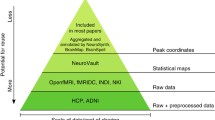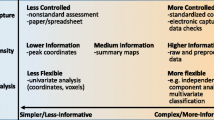Abstract
The development of neuroimaging instrumentation has boosted neuroscience researches. Consequently, both the fineness and the cost of data acquisition have profoundly increased, leading to the main bottleneck of this field: limited sample size and high dimensionality of neuroimaging data. Therefore, the emphasis of ideas of data pooling and research collaboration has increased over the past decade. Collaborative analysis techniques emerge as the idea developed. In this paper, we present NEURO-LEARN, a solution for collaborative pattern analysis of neuroimaging data. Its collaboration scheme consists of four parts: projects, data, analysis, and reports. While data preparation workflows defined in projects reduce the high dimensionality of neuroimaging data by collaborative computation, pooling of derived data and sharing of pattern analysis workflows along with generated reports on the Web enlarge the sample size and ensure the reliability and reproducibility of pattern analysis. Incorporating this scheme, NEURO-LEARN provides an easy-to-use Web application that allows users from different sites to share projects and processed data, perform pattern analysis, and obtain result reports. We anticipate that this solution will help neuroscientists to enlarge sample size, conquer the curse of dimensionality and conduct reproducible studies on neuroimaging data with efficiency and validity.







Similar content being viewed by others
References
Arbabshirani, M. R., Plis, S., Sui, J., & Calhoun, V. D. (2017). Single subject prediction of brain disorders in neuroimaging: Promises and pitfalls. Neuroimage, 145(Pt B), 137–165. https://doi.org/10.1016/j.neuroimage.2016.02.079.
Baker, B. T., Silva, R. F., Calhoun, V. D., Sarwate, A. D., & Plis, S. M. (2015). Large scale collaboration with autonomy. Decentralized data ICA (Vol. 2015-November): IEEE Computer Society.
Breiman, L. (1996). Bagging predictors. Machine Learning, 24(2), 123–140.
Bzdok, D., & Meyer-Lindenberg, A. (2018). Machine learning for precision psychiatry: Opportunities and challenges. Biological Psychiatry: Cognitive Neuroscience and Neuroimaging, 3(3), 223–230. https://doi.org/10.1016/j.bpsc.2017.11.007.
Carter Kw Fau, Francis, R. W., Fau F. R., Carter, K. W., Bresnahan, M., Gissler, M., et al. (n.d.) ViPAR: a software platform for the Virtual Pooling and Analysis of Research Data. Electronic. 1464–3685.
Chang, K., Balachandar, N., Lam, C., Yi, D., Brown, J., Beers, A., Rosen, B., Rubin, D. L., & Kalpathy-Cramer, J. (2018). Distributed deep learning networks among institutions for medical imaging. Journal of the American Medical Informatics Association, 25(8), 945–954. https://doi.org/10.1093/jamia/ocy017.
Chaudhuri, K., Monteleoni, C., & Sarwate, A. D. (2011). Differentially private empirical risk minimization. Journal of Machine Learning Research, 12, 1069–1109.
Cohen, J. (1998). Statistical power analysis for the behavioural sciences. Journal of the American Statistical Association, 73.
Cui, Z., Zhong, S., Xu, P., He, Y., & Gong, G. (2013). PANDA: A pipeline toolbox for analyzing brain diffusion images. Front Hum Neurosci, 7, 42. https://doi.org/10.3389/fnhum.2013.00042.
Dluhos, P., Schwarz, D., Cahn, W., van Haren, N., Kahn, R., Spaniel, F., et al. (2017). Multi-center machine learning in imaging psychiatry: A meta-model approach. Neuroimage, 155, 10–24. https://doi.org/10.1016/j.neuroimage.2017.03.027.
Durbin, R., & Willshaw, D. (1987). An analogue approach to the travelling salesman problem using an elastic net method. Nature, 326(6114), 689–691.
Fischl, B. (2012). FreeSurfer. Neuroimage, 62(2), 774–781. https://doi.org/10.1016/j.neuroimage.2012.01.021.
Fisher, R. A. (1936). The use of multiple measurements in taxonomic problems. Ann Eugenics, 7(2), 179–188. https://doi.org/10.1111/j.1469-1809.1936.tb02137.x.
Frasse, J., Williams, J., & San, A. (1989). Ordinary least squares vs.
Gaye, A., Marcon, Y., Isaeva, J., LaFlamme, P., Turner, A., Jones, E. M., et al. (n.d.). DataSHIELD: taking the analysis to the data, not the data to the analysis. Electronic. 1464–3685.
Gazula, H., Baker, B. T., Damaraju, E., Plis, S. M., Panta, S. R., Silva, R. F., & Calhoun, V. D. (2018). Decentralized analysis of brain imaging data: Voxel-based Morphometry and dynamic functional network connectivity. Front Neuroinform, 12, 55. https://doi.org/10.3389/fninf.2018.00055.
Guyon, I., & Elisseeff, A. (2003). An Introduction of Variable and Feature Selection (Vol. 3).
Hoerl, A., & Kennard, R. (2000). Ridge regression: Biased estimation for nonorthogonal problems. Technometrics, 12(1), 55–67.
Hunter, J. D. (2007). Matplotlib: A 2D graphics environment. Computing in Science & Engineering, 9(3), 90–95. https://doi.org/10.1109/MCSE.2007.55.
Joliffe, I. T., & Morgan, B. (1992). Principal component analysis and exploratory factor analysis. Stat Methods Med Res, 1(1), 69–95. https://doi.org/10.1177/096228029200100105.
Kennedy, D. N., Abraham, S. A., Bates, J. F., Crowley, A., Ghosh, S., Gillespie, T., Goncalves, M., Grethe, J. S., Halchenko, Y. O., Hanke, M., Haselgrove, C., Hodge, S. M., Jarecka, D., Kaczmarzyk, J., Keator, D. B., Meyer, K., Martone, M. E., Padhy, S., Poline, J. B., Preuss, N., Sincomb, T., & Travers, M. (2019). Everything matters: The ReproNim perspective on reproducible neuroimaging. Front Neuroinform, 13, 1. https://doi.org/10.3389/fninf.2019.00001.
Liu, S., Cai, W., Liu, S., Zhang, F., Fulham, M., Feng, D., Pujol, S., & Kikinis, R. (2015). Multimodal neuroimaging computing: The workflows, methods, and platforms. Brain Inform, 2(3), 181–195. https://doi.org/10.1007/s40708-015-0020-4.
Millman, K. J., & Brett, M. (2007). Analysis of functional magnetic resonance imaging in Python. Computing in Science & Engineering, 9(3), 52–55.
Mwangi, B., Tian, T. S., & Soares, J. C. (2014). A review of feature reduction techniques in neuroimaging. Neuroinformatics, 12(2), 229–244. https://doi.org/10.1007/s12021-013-9204-3.
Neuro Cloud Consortium. Electronic address, j. j. e., & Neuro Cloud, C. (2016). To the cloud! A grassroots proposal to accelerate brain science discovery. Neuron, 92(3), 622–627. https://doi.org/10.1016/j.neuron.2016.10.033.
Nieuwenhuis, M., van Haren, N. E. M., Hulshoff Pol, H. E., Cahn, W., Kahn, R. S., & Schnack, H. G. (2012). Classification of schizophrenia patients and healthy controls from structural MRI scans in two large independent samples. Neuroimage, 61(3), 606–612. https://doi.org/10.1016/j.neuroimage.2012.03.079.
Pardoe, H. R., & Kuzniecky, R. (2018). NAPR: A cloud-based framework for neuroanatomical age prediction. Neuroinformatics, 16(1), 43–49. https://doi.org/10.1007/s12021-017-9346-9.
Pedregosa, F., Gramfort, A., Michel, V., Thirion, B., Grisel, O., Blondel, M., et al. (2013). Scikit-learn: Machine learning in Python. J Mach Learn Res, 12(10), 2825–2830.
Peng, C.-Y. J., Lee, K. L., & Ingersoll, G. M. (2002). An introduction to logistic regression analysis and reporting. J Educ Res, 96(1), 3–14. https://doi.org/10.1080/00220670209598786.
Pereira, F., Mitchell, T., & Botvinick, M. (2009). Machine learning classifiers and fMRI: A tutorial overview. Neuroimage, 45(1 Suppl), S199–S209. https://doi.org/10.1016/j.neuroimage.2008.11.007.
Plis, S. M., Sarwate, A. D., Wood, D., Dieringer, C., Landis, D., Reed, C., Panta, S. R., Turner, J. A., Shoemaker, J. M., Carter, K. W., Thompson, P., Hutchison, K., & Calhoun, V. D. (2016). COINSTAC: A privacy enabled model and prototype for leveraging and processing decentralized brain imaging data. Front Neurosci, 10, 365. https://doi.org/10.3389/fnins.2016.00365.
Roth, A., & Dwork, C. (2013). The algorithmic foundations of differential privacy. Foundations and Trends® in Theoretical Computer Science, 9(3–4), 211–407. https://doi.org/10.1561/0400000042.
Sarwate, A., Plis, S., Turner, J., Arbabshirani, M., & Calhoun, V. (2014). Sharing privacy-sensitive access to neuroimaging and genetics data: A review and preliminary validation. Frontiers in Neuroinformatics, 8, 35. https://doi.org/10.3389/fninf.2014.00035.
Thompson, P. M., Andreassen, O. A., Arias-Vasquez, A., Bearden, C. E., Boedhoe, P. S., Brouwer, R. M., et al. (2017). ENIGMA and the individual: Predicting factors that affect the brain in 35 countries worldwide. Neuroimage, 145(Pt B), 389–408. https://doi.org/10.1016/j.neuroimage.2015.11.057.
Thompson, P. M., Stein, J. L., Medland, S. E., Hibar, D. P., Vasquez, A. A., Renteria, M. E., et al. (2014). The ENIGMA consortium: Large-scale collaborative analyses of neuroimaging and genetic data. Brain imaging and behavior, 8(2), 153–182. https://doi.org/10.1007/s11682-013-9269-5.
Tibshirani, R. (1996). Regression shrinkage and selection via the lasso. J R Stat Soc, 58(1), 267–288.
Vapnik, V. N. (1995). The nature of statistical learning theory.
Weiner, M. W., Veitch, D. P., Aisen, P. S., Beckett, L. A., Cairns, N. J., Green, R. C., Harvey, D., Jack, C. R., Jagust, W., Liu, E., Morris, J. C., Petersen, R. C., Saykin, A. J., Schmidt, M. E., Shaw, L., Shen, L., Siuciak, J. A., Soares, H., Toga, A. W., Trojanowski, J. Q., & Alzheimer's Disease Neuroimaging Initiative. (2013). The Alzheimer's disease neuroimaging initiative: A review of papers published since its inception. Alzheimer's & Dementia: The Journal of the Alzheimer's Association, 9(5), e111–e194. https://doi.org/10.1016/j.jalz.2013.05.1769.
Wu, F., Zhang, Y., Yang, Y., Lu, X., Fang, Z., Huang, J., Kong, L., Chen, J., Ning, Y., Li, X., & Wu, K. (2018). Structural and functional brain abnormalities in drug-naive, first-episode, and chronic patients with schizophrenia: A multimodal MRI study. Neuropsychiatr Dis Treat, 14, 2889–2904. https://doi.org/10.2147/NDT.S174356.
Yan, C. G., Wang, X. D., Zuo, X. N., & Zang, Y. F. (2016). DPABI: Data Processing & Analysis for (resting-state) brain imaging. Neuroinformatics, 14(3), 339–351. https://doi.org/10.1007/s12021-016-9299-4.
Zang, Y., Jiang T. Fau, Lu Y., Lu Y. Fau - He, Y., He Y Fau Tian, L. (n.d.) Regional homogeneity approach to fMRI data analysis. (1053–8119 (Print)).
Zhang, Z. (2016). Introduction to machine learning: K-nearest neighbors. Annals of Translational Medicine, 4(11), 218–218. https://doi.org/10.21037/atm.2016.03.37.
Acknowledgements
The NEURO-LEARN project was inspired by Prof. Kai Wu’s work on MVPA of multi-modal neuroimaging. Part of the pattern analysis models was initially coded by Yue Zhang. We acknowledge the help from Kaixi Wang during the development of the Web application of NEURO-LEARN. And we are further thankful for the imaging data provided by Dr. Fengchun Wu and Prof. Yuping Ning. This work was supported by the National Natural Science Foundation of China (31771074, 81802230), the Science and Technology Program of Guangdong (2016B010108003, 2016A020216004, 2017A040405059, 2018B030335001), the Science and Technology Program of Guangzhou (201604020170, 201704020168, 201704020113, 201807010064, 201803010100, 201903010032).
Author information
Authors and Affiliations
Contributions
The Web application of NEURO-LEARN has been developed and coded by Bingye Lei, with substantial contributions and instructions from Kaixi Wang, Prof. Kai Wu and Prof. Jun Chen. Dr. Fengchun Wu and Prof. Yuping Ning were in charge of the acquisition and processing of raw imaging data. Dr. Jing Zhou and Prof. Dongsheng Xiong were responsible for the data preprocessing and feature computing. Lingyin Kong and Pengfei Ke developed the modules of local workflows of the example project and tested them. All authors contributed to the documentation. Bingye Lei, Prof. Xiaobo Li, Prof. Zhiming Xiang, and Prof. Kai Wu wrote and revised the manuscript. All authors contributed to and approved the final version of the paper and agreed to be accountable for the content of this work.
Corresponding author
Additional information
Publisher’s Note
Springer Nature remains neutral with regard to jurisdictional claims in published maps and institutional affiliations.
Electronic supplementary material
ESM 1
(CSV 11 kb)
Rights and permissions
About this article
Cite this article
Lei, B., Wu, F., Zhou, J. et al. NEURO-LEARN: a Solution for Collaborative Pattern Analysis of Neuroimaging Data. Neuroinform 19, 79–91 (2021). https://doi.org/10.1007/s12021-020-09468-6
Published:
Issue Date:
DOI: https://doi.org/10.1007/s12021-020-09468-6




